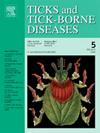Parthenogenetic Haemaphysalis longicornis acetylcholinesterases are triggered by the repellent effect of cinnamaldehyde, a primary compound found in cinnamon oil
IF 3.1
2区 医学
Q2 INFECTIOUS DISEASES
引用次数: 0
Abstract
The control and prevention of ticks and tick-borne diseases rely on chemical insecticides and repellents. Plant-derived compounds potentially represent new and safer repellents. Cinnamaldehyde, a component of cinnamon oil, exhibits antibacterial, anti-inflammatory, acaricidal, and repellent activity against ticks. Here we studied the molecular mechanism of the repellent effect of cinnamaldehyde on Haemaphysalis longicornis. A 2 % cinnamaldehyde treatment resulted in >90 % nymph repellency within 6 h. Nymphs were exposed to cinnamaldehyde for 30 min, and subsequent transcriptome and metabolome analyses revealed the involvement of H. longicornis Acetylcholinesterases (HL-AchEs) in the response process. HL-AchEs was transcribed in all tick developmental stages and tissues. Following cinnamaldehyde treatment, the transcript and specific activity of the enzyme of AchE were significantly altered. Following RNAi, electroantennography (EAG) tests demonstrated a significant decrease in response to various repellents as well as a significant decrease in repellency. Our findings have revealed that HL-AchEs mediates cinnamaldehyde-induced tick repellency, and the results provide insights into the mechanism of plant-derived tick repellents.
肉桂油中的主要化合物肉桂醛的驱避作用会触发孤雌生殖的长角蟾乙酰胆碱酯酶
蜱虫和蜱传疾病的控制和预防依赖于化学杀虫剂和驱虫剂。植物提取的化合物可能是更安全的新型驱虫剂。肉桂醛是肉桂油的一种成分,具有抗菌、消炎、杀螨和驱赶蜱虫的活性。在这里,我们研究了肉桂醛对长角蜱(Haemaphysalis longicornis)驱避作用的分子机制。将若虫暴露在肉桂醛中 30 分钟,随后的转录组和代谢组分析表明,H. longicornis 乙酰胆碱酯酶(HL-AchEs)参与了反应过程。HL-AchEs 在蜱的所有发育阶段和组织中都有转录。肉桂醛处理后,AchE 酶的转录本和特异活性发生了显著变化。在 RNAi 之后,电测听(EAG)测试表明,蜱对各种驱避剂的反应明显降低,驱避力也明显下降。我们的研究结果表明,HL-AchEs介导了肉桂醛诱导的蜱驱避作用,这些结果为了解植物提取的蜱驱避剂的机制提供了启示。
本文章由计算机程序翻译,如有差异,请以英文原文为准。
求助全文
约1分钟内获得全文
求助全文
来源期刊

Ticks and Tick-borne Diseases
INFECTIOUS DISEASES-MICROBIOLOGY
CiteScore
6.90
自引率
12.50%
发文量
185
审稿时长
6-12 weeks
期刊介绍:
Ticks and Tick-borne Diseases is an international, peer-reviewed scientific journal. It publishes original research papers, short communications, state-of-the-art mini-reviews, letters to the editor, clinical-case studies, announcements of pertinent international meetings, and editorials.
The journal covers a broad spectrum and brings together various disciplines, for example, zoology, microbiology, molecular biology, genetics, mathematical modelling, veterinary and human medicine. Multidisciplinary approaches and the use of conventional and novel methods/methodologies (in the field and in the laboratory) are crucial for deeper understanding of the natural processes and human behaviour/activities that result in human or animal diseases and in economic effects of ticks and tick-borne pathogens. Such understanding is essential for management of tick populations and tick-borne diseases in an effective and environmentally acceptable manner.
 求助内容:
求助内容: 应助结果提醒方式:
应助结果提醒方式:


